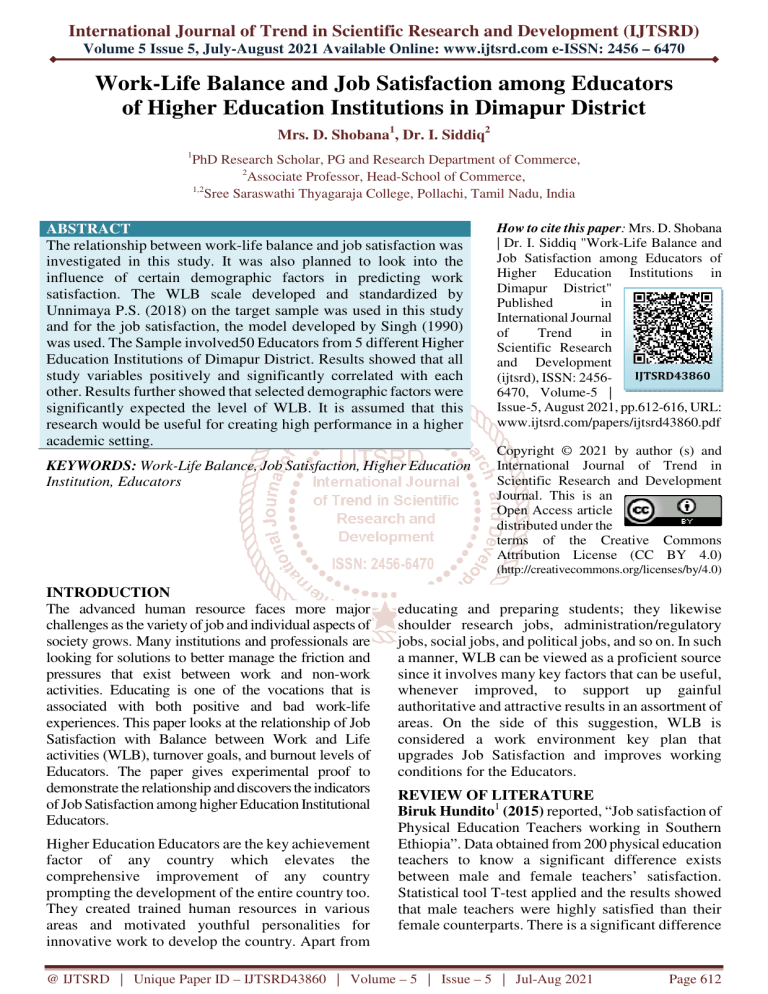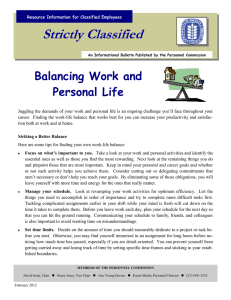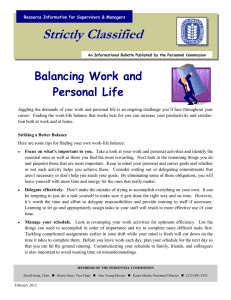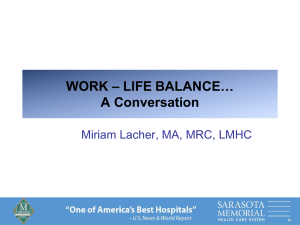
International Journal of Trend in Scientific Research and Development (IJTSRD)
Volume 5 Issue 5, July-August 2021 Available Online: www.ijtsrd.com e-ISSN: 2456 – 6470
Work-Life Balance and Job Satisfaction among Educators
of Higher Education Institutions in Dimapur District
Mrs. D. Shobana1, Dr. I. Siddiq2
1
PhD Research Scholar, PG and Research Department of Commerce,
2
Associate Professor, Head-School of Commerce,
1,2
Sree Saraswathi Thyagaraja College, Pollachi, Tamil Nadu, India
ABSTRACT
The relationship between work-life balance and job satisfaction was
investigated in this study. It was also planned to look into the
influence of certain demographic factors in predicting work
satisfaction. The WLB scale developed and standardized by
Unnimaya P.S. (2018) on the target sample was used in this study
and for the job satisfaction, the model developed by Singh (1990)
was used. The Sample involved50 Educators from 5 different Higher
Education Institutions of Dimapur District. Results showed that all
study variables positively and significantly correlated with each
other. Results further showed that selected demographic factors were
significantly expected the level of WLB. It is assumed that this
research would be useful for creating high performance in a higher
academic setting.
KEYWORDS: Work-Life Balance, Job Satisfaction, Higher Education
Institution, Educators
How to cite this paper: Mrs. D. Shobana
| Dr. I. Siddiq "Work-Life Balance and
Job Satisfaction among Educators of
Higher Education Institutions in
Dimapur District"
Published
in
International Journal
of
Trend
in
Scientific Research
and Development
IJTSRD43860
(ijtsrd), ISSN: 24566470, Volume-5 |
Issue-5, August 2021, pp.612-616, URL:
www.ijtsrd.com/papers/ijtsrd43860.pdf
Copyright © 2021 by author (s) and
International Journal of Trend in
Scientific Research and Development
Journal. This is an
Open Access article
distributed under the
terms of the Creative Commons
Attribution License (CC BY 4.0)
(http://creativecommons.org/licenses/by/4.0)
INTRODUCTION
The advanced human resource faces more major
challenges as the variety of job and individual aspects of
society grows. Many institutions and professionals are
looking for solutions to better manage the friction and
pressures that exist between work and non-work
activities. Educating is one of the vocations that is
associated with both positive and bad work-life
experiences. This paper looks at the relationship of Job
Satisfaction with Balance between Work and Life
activities (WLB), turnover goals, and burnout levels of
Educators. The paper gives experimental proof to
demonstrate the relationship and discovers the indicators
of Job Satisfaction among higher Education Institutional
Educators.
Higher Education Educators are the key achievement
factor of any country which elevates the
comprehensive improvement of any country
prompting the development of the entire country too.
They created trained human resources in various
areas and motivated youthful personalities for
innovative work to develop the country. Apart from
educating and preparing students; they likewise
shoulder research jobs, administration/regulatory
jobs, social jobs, and political jobs, and so on. In such
a manner, WLB can be viewed as a proficient source
since it involves many key factors that can be useful,
whenever improved, to support up gainful
authoritative and attractive results in an assortment of
areas. On the side of this suggestion, WLB is
considered a work environment key plan that
upgrades Job Satisfaction and improves working
conditions for the Educators.
REVIEW OF LITERATURE
Biruk Hundito1 (2015) reported, “Job satisfaction of
Physical Education Teachers working in Southern
Ethiopia”. Data obtained from 200 physical education
teachers to know a significant difference exists
between male and female teachers’ satisfaction.
Statistical tool T-test applied and the results showed
that male teachers were highly satisfied than their
female counterparts. There is a significant difference
@ IJTSRD | Unique Paper ID – IJTSRD43860 | Volume – 5 | Issue – 5 | Jul-Aug 2021
Page 612
International Journal of Trend in Scientific Research and Development @ www.ijtsrd.com eISSN: 2456-6470
between male and female teachers who are working
in private schools in Ethiopia.
Goud and Nagaraju2 (2013) conducted a study on,
“Work-life Balance of Teaching Faculty with
reference to Andhra Pradesh Engineering College.
The issues connected with the work-life balance of
faculty members in Education Institutions and the
factors that determine work-life balance were
highlighted in this study. 210 respondents from 14
engineering colleges of the Rayalaseema region and
Andhra Pradesh were selected using the Stratified
Random Sampling method. The major objective of
this study was to examine the effect of work-life
balance on faculties’ performance and work attitude.
Suguna and Vandhana3 (2013) extended, “A Study
on Work-Life Balance among Teachers”. The major
objective of this study was to know the level of worklife balance among Educators. The data was collected
through primary data by circulating questionnaires to
74 sample respondents belongs to different
professional colleges.
Research Gap:
The current effort has never been concentrated in
endeavouring the number of occupants in Higher
Education Institutional Educators, according to the
review of literature. By conducting this research, it
will provide an obvious job of nature of work-life
equivalent to Job Satisfaction, especially for those
working in Higher Education Institutions. The
outcomes of this study are expected to assist
policymakers in carrying out suitable discussions in
order to maintain educator job satisfaction. The
researcher's goal in this study was to do research in
Nagaland, a state in North-East India. As a result, the
information gathered from respondents from Dimapur
District Higher Education Institutions.
Objectives
The aims of the current research study are following:
1. To investigate the link between educator job
satisfaction and work-life balance.
2. To look at the effect of certain demographic
characteristics in predicting Work-Life Balance.
Hypotheses
Following assumptions were hypothesized on the
basis of the literature review:
2
Madhusudhan Goud. V and Nagaraju.K (2013), ‘Worklife Balance of Teaching Faculty with Reference to
Andhra Pradesh Engineering Colleges’, Global Journal
of Management and Business Studies, Vol. 3, No. 8, pp.
891-896
3
Dr. Konda Suguna and Vandhana R (2013), ‘A Study on
Work-Life Balance among Teachers’, Personnel Today,
July – September 2013, pp 15 – 22.
1. There will be a positive relationship between
Work-life Balance and Job Satisfaction.
2. Selected demographic variables will influence the
Work-life Balance.
Method
Sample
The sample for this research comprised of 50
Educators from 5 Higher Education Institutions in
Dimapur District. The sample was employed by
stratified random sampling technique from different
faculties of those Higher Education Institutions in
Dimapur District of Nagaland, India.
Instruments
The questionnaire was used to obtain information
about the participants along with two parts:
1. Demographic Profile
2. Work-life Balance
3. Job Satisfaction
Work-life Balance Scale
The WLB scale developed and standardized by
Unnimaya P.S. (2018) on the target sample was used
in this study. The scale measuring three dimensions
of WLB such as Work Interfering Personal Life,
Personal Life Interfering Work, and Work/Personal
Life Enhancement. The scale comprises 15 items on
a 5-point Likert scale anchored from “1” (Not at all)
to “5” (All the time). The possible scores can range
from 15 to 75. Thus higher scores state a higher level
of WLB.
Cronbach’s alpha of the scale was observed at 0.839
and showed excellent reliability of the scale. KaiserMeyer-Olkin Measure of Sampling Adequacy (KMO)
and Bartlett’s Test of Sphericity to know whether the
relationship among the variables is significant or not.4
The KMO Measure of sampling adequacy showed the
value of test statistics is 0.904, which means the
factor analysis for the selected variable was found to
be appropriate to the data.
The results of the factor analysis presented in the
thesis regarding factors related to the level of
agreement in relation to Work-life, have revealed that
there are nineteen factors that had Eigen value
exceeding “one”. Among those four factors, the first
factor accounted for 42.484 percent of the variance,
the second 10.354 percent. The first four factors were
the final factors and they all together represent 52.838
percent of the total variance in the scale items
measuring the related to the level of agreement in
relation to Work-life n. hence from the above results,
4
Nargundkar, Rajendra, Marketing Research- Text and
Cases, Tata McGraw Hill, New Delhi, 2nd Ed-2003,
Pp.312 – 313
@ IJTSRD | Unique Paper ID – IJTSRD43860 | Volume – 5 | Issue – 5 | Jul-Aug 2021
Page 613
International Journal of Trend in Scientific Research and Development @ www.ijtsrd.com eISSN: 2456-6470
it is certain that is related to the level of agreement in relation to Work-life.5
Job Satisfaction Scale
The Job satisfaction scale developed by Singh (1990) was used. This scale is composed of 15 items. The
responses were on a 5-point Likert rating scale had anchors of “1” (Highly Dissatisfied) to “5” (Highly
Satisfied). The possible scores can range from 15 to 75. Thus higher scores state a higher level of organizational
commitment. The scale's reliability coefficient was 0.96. The reliability of the scale was found to be excellent
with a Cronbach’s alpha of 0.91 in the present study (George &Mallery, 2003).
Results
Pearson Correlation Analysis
Pearson Correlation was computed to evaluate the relationship between the Level of Work-life Balance and Job
Satisfaction of Educators. The following table revealed that there is a 10.2percentage of a negative relationship
between WLB and Job Satisfaction and WLB (p 0.483 >0.05).
Table 1 shows the Normality Testing Results to proceed with Pearson Correlation Analysis
Std.
Normality
Variables Mean Median
Skewness Kurtosis
Result
Deviation
Testing Values
Level of
1.90
2.00
.580
.000
.063
0.00
0.10
Normal
WLB
Over all Job
2.44
2.00
1.146
.747
.026
2.22
0.04
Normal
Satisfaction
N=50, Std. Error of Skewness=0.337, Std. Error of Kurtosis=0.662
Source: Primary Data
Table 2 Relationship between Level of WLB and Overall Job Satisfaction (Correlations)
Level of Work-life Balance
Pearson Correlation
-.102
Overall Job Satisfaction Level
Sig. (2-tailed)
.483
N
50
Source: Primary Data
Hence, H1 is supported and concluded that therewill be a positive relationship between Work-life Balance and
Job Satisfaction.
Multiple Regression Analysis
Table 3 shows the Normality Testing Results to proceed with Regression Analysis
Std.
Normality Testing
Variables
Mean Median
Skewness Kurtosis
Result
Deviation
Values
Designation
1.06 1.00
.314
5.596
32.438
16.63
49.01 Not normal
Qualification
4.68 5.00
2.394
.423
-.585
1.26
-0.88 Normal
Profession Category
1.86 2.00
.351
-2.140
2.684
-6.36
4.06
Not normal
Major Subject
3.32 3.00
1.766
.901
-.026
2.68
-0.04 Normal
Handling Course
1.36 1.00
.663
1.638
1.368
4.87
2.07
Not normal
Experience
2.48 2.00
.814
.540
.910
1.60
1.37
Normal
Monthly Income Level 2.18 2.00
.691
1.295
2.273
3.85
3.43
Not normal
Working Under the
2.74 2.00
1.275
1.006
-.603
2.99
-0.91 Normal
Institution
Living Area
2.12 2.00
.689
-.160
-.826
-0.48
-1.25 Normal
Native State
2.32 1.00
2.436
1.921
2.481
5.71
3.75
Not normal
Gender
1.48 1.00
.505
.083
-2.078
0.25
-3.14 Normal
Marital Status
1.48 1.00
.505
.083
-2.078
0.25
-3.14 Normal
Age Group
2.62 2.00
1.563
1.070
.893
3.18
1.35
Normal
Type of family
1.26 1.00
.443
1.128
-.759
3.35
-1.15 Normal
Number of dependents 2.28 2.00
1.011
.511
-.757
1.52
-1.14 Normal
5
B. Balanagalakshmi, M.Phil Thesis on Impact of Work-life Balance among College Teachers in Coimbatore City, 2016
@ IJTSRD | Unique Paper ID – IJTSRD43860 | Volume – 5 | Issue – 5 | Jul-Aug 2021
Page 614
International Journal of Trend in Scientific Research and Development @ www.ijtsrd.com eISSN: 2456-6470
Nature of the
dependents
Level of WLB
2.80
2.00
1.874
.438
-1.416
1.30
-2.14
Normal
1.90 2.00
.580
.000
.063
0.00
0.10
N=50, Std. Error of Skewness=0.337, Std. Error of Kurtosis=0.662
Source: Primary Data
Normal
Table 4 shows Regression analysis of selected demographic variables and Level of Work-life Balance.
ANOVAa,b
Model
Sum of Squares Df Mean Square
F
Sig.
Regression
184.190
8
23.024
75.491 .000c
1
Residual
12.810
42
.305
Total
197.000d
50
a. Dependent Variable: Level of Work-life Balance
b. Linear Regression through the Origin
c. Predictors: Type of family, Qualification, Age Group, Gender, Marital
Status, Designation, Monthly Income Level, Experience
d. This total sum of squares is not corrected for the constant because the
constant is zero for regression through the origin.
Source: Primary Data
Coefficientsa,b
Unstandardized Coefficients Standardized Coefficients
Model
t
Sig.
B
Std. Error
Beta
Designation
-.469
.276
-.261
-1.696 .097
Qualification
.095
.033
.250
2.838 .007
Experience
.258
.129
.339
2.000 .052
Monthly Income Level
-.032
.146
-.037
-.220 .827
1
Gender
.363
.133
.285
2.725 .009
Marital Status
.381
.160
.300
2.380 .022
Age Group
.149
.067
.229
2.224 .032
Type of family
-.106
.182
-.071
-.583 .563
a. Dependent Variable: Level of Work-life Balance
b. Linear Regression through the Origin
Source: Primary Data
The Qualification, Age Group, Gender, and Marital Status, are passed the criteria to influence the Work-life
Balance.
The Designation, Monthly Income Level, Experience and Type of family, are not passed the criteria to influence
the Work-life Balance. Therefore, H2 is supported that Selected demographic variables (Qualification, Age
Group, Gender, and Marital Status) will influence the Work-life Balance.
Discussion
The obtained results confirmed that WLB and Job
Satisfaction negatively correlate with one another.
Besides, some demographic variables of the
respondents are altogether and positively influence
the WLB and few demographic variables negatively
influence WLB.
Conclusion
Employees' high job satisfaction brings a greater
motivation, inspiration, positive feeling, mentality
and decreases turnover, absenteeism among them
which empowers them to show the greatest exertion
in accomplishing the organizational objectives. Since
satisfaction can trigger prompt emotional responses.
Accordingly, it's anything but a central part of the
improvement of teachers' overall performance. Thus
apparently, WLB shapes and balances out fulfillment.
Analyzing the work-life balance and job satisfaction
of Educators can help the Education Institutions to
identify factors that contribute to the individual as
well as institutional development by improved
performance as an outcome of successfully balanced
work-life and job satisfaction and of the employee. It
is suggested that researchers need to pay more
attention to different other factors in future studies of
work-life balance on job commitment and
performance.
References
[1] Adawiyah Safirah, Cahya Dewi Karisga,
Refiana Noveriza, Reyhan Fatwa Mosyani
@ IJTSRD | Unique Paper ID – IJTSRD43860 | Volume – 5 | Issue – 5 | Jul-Aug 2021
Page 615
International Journal of Trend in Scientific Research and Development @ www.ijtsrd.com eISSN: 2456-6470
dan Setyo Riyanto. 2019. The effect of Worklife Balance and Employee Satisfaction
on Employee Loyalty Ofgpret Studio. Journal
Of Humanities And Social Science. Fakultas
Ekonomi dan Bisnis Universities Mercu
Buana. Vol.25 No.1
[9]
Herzberg, Frederick. 2011. Herzberg’s
Motivation – Hygiene theory and job
satisfaction ini The Malaysian Retail Sector:
The Mediating Effect Of Love Money.
Sunway University Malaysia: Teek Hang Tan
and Amna Waheed
[2]
A.A Anwar Prabu Mangkunegara 2016.
Manajemen
Sumber
Daya
Manusia
Perusahaan, Penerbit Bandung : Remaja
Rosdakarya
[10]
Hudson. 2005. The Case for Work-Life
Balance. 20:20 Series. E-book The Case for
Work/Life Balance: Closing the Gap Between
Policy and Practice.
[3]
Edy Sutrisno, 2011, Manajemen Sumber
Daya Manusia, Jakarta: Kencana
[11]
Kasmir. 2016. Manajemen Sumber Daya
Manusia, PT. Raja Grafindo Persada, Jakarta.
[4]
Fisher-McAuley, G.,Stanton, J.,Jolton,J.,&
Gavin, J. (2003). Modeling the relationship
between work life balance and organizational
outcomes. Paper presented at the Annual
Conference of the Society for IndustrialOrganisational Psychology. 1-26.
[12]
Logahan, Jerry Marcellinus. 2009. “Pengaruh
Lingkungan Kerja dan Stres Pekerjaan
Terhadap Kinerja Pekerja di PT Nemanac
Rendem”. Tarakanita.
[13]
Ganapathi, I Made Devan, AliniGilang. 2016.
Pengaruh Work-Life Balance Terhadap
Kepuasan Kerja Karyawan (Studi Pada PT.
Bio Farma Persero. E-Jurnal Ecodemica, Vol.
IV No. 1 April 2016. Fakultas Komunikasi
dan Bisnis, Universitas Telkom Bandung.
McDonald, P., Bradley, L., and Brown, K.
2005. Explanations for The Provision
Utilization Gap in Work-Family Policy.
Woman in Management Review (in press).
[14]
Handoko, T. Hani, 2005, Manajemen
Personalia dan SumberDaya, B. P. F. E.
UGM, Yogyakarta
Richard L. Hughes, Robert C. Ginnett, and
Gordon J. Curphy. 2012. Leadership,
Enhancing the Lessons of Experience, Alih
Bahasa: Putri Izzati. Jakarta: Salemba
Humanika.
[15]
Riyanto, S., Ariyanto, E., & Lukertina, L.
(2019). Work-life Balance and its Influence
on Employee Engagement “Y” Generation in
Courier Service Industry. International
Review of Management and Marketing, 9(6),
25-31.
[16]
Weckstein, Stacey Hoffer. 2008. How To
Practice The Art Of Life Balance. E-book.
Copyright: Stacey Weckstein Hoffer
[5]
[6]
[7]
Hasibuan, Malayu S.P. 2009. Manajemen
Sumber Daya Manusia (Edisi revisicetakan ke
tiga belas). Jakarta: PT Bumi Aksara
[8]
Hasibuan, Malayu S.P. 2016. Manajemen
Sumber Daya Manusia. Edisi Revisi. Jakarta:
Penerbit PT Bumi Aksara.
@ IJTSRD | Unique Paper ID – IJTSRD43860 | Volume – 5 | Issue – 5 | Jul-Aug 2021
Page 616



